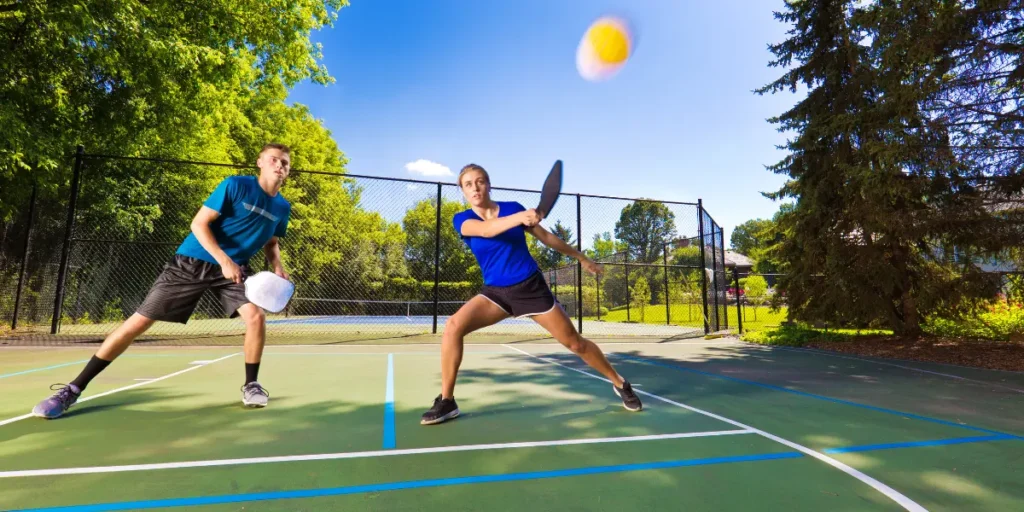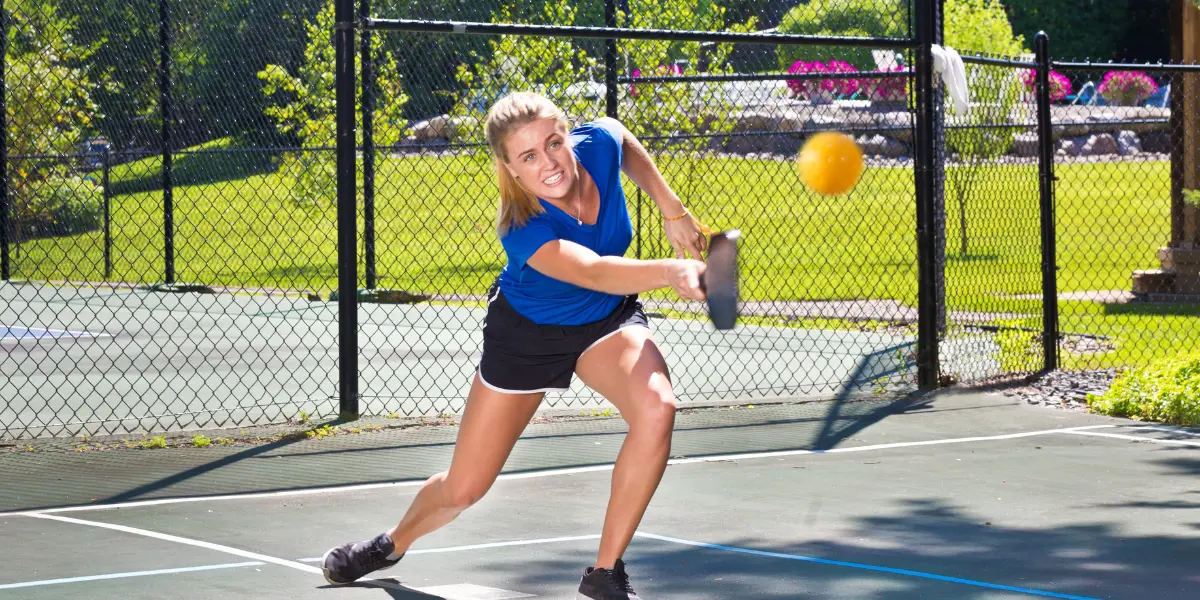Struggling to get that extra edge on your shots? Mastering how to spin a pickleball might be the game-changer you’ve been missing. Whether it’s dropping a tricky topspin serve or slicing a sharp backhand dink, spin makes your shots harder to read and even harder to return.
The good news? You don’t need to be a pro to do it. With the right grip, paddle angle, and a few technique tweaks, you can start adding spin to your game today, even if you’ve never tried it before.
Let’s break down how it’s done step by step.
3 Types of Spin in Pickleball
1. Topspin
Topspin causes the ball to dip quickly and bounce forward aggressively. It’s created by brushing the paddle upward across the back of the ball. This spin is ideal for fast groundstrokes and third-shot drops, helping the ball clear the net safely while forcing low, difficult returns.
2. Backspin (Slice)
Backspin, also called slice, causes the ball to float gently and skid low on the bounce. You create it by cutting down the back of the ball with an open paddle face. It’s most useful for dinks, defensive shots, and resets, making it harder for opponents to attack.
3. Sidespin
Sidespin makes the ball curve left or right through the air, depending on paddle direction. Though used less frequently, it can be very deceptive on serves or cross-court shots, forcing opponents into awkward returns.
When Each Type Is Useful
- Use topspin to stay aggressive, especially on baseline shots and fast-paced rallies.
- Apply backspin to control the pace or neutralize hard-hitting opponents.
- Throw in sidespin to keep your opponent guessing and force weak returns.
Mastering these spins takes time, but even adding one reliably into your game can change how your rallies play out.
Basic Grip and Paddle Angle for Spin
Eastern vs Continental Grip
Most players choose between two main grip types: the Eastern and Continental. The Eastern grip feels like a handshake and offers a great balance between control and topspin, making it ideal for forehand drives and topspin rolls.
The Continental grip is more neutral and is often used near the net. It’s especially effective for backspin and slice shots, though it may not be ideal for generating heavy topspin.
Adjusting Paddle Face and Wrist Motion
To create spin, the angle of your paddle at contact matters just as much as your grip. For topspin, slightly close the paddle face and brush upward on the ball. For backspin, open the paddle slightly and slice down and under.
Adding a controlled flick of the wrist during contact enhances spin, but it must be timed properly to maintain shot accuracy.
How to Put Topspin on a Pickleball
To generate topspin, start your swing low and move upward in a smooth motion. Your paddle face should be slightly closed (tilted forward), and you need to brush up the back of the ball, not strike it flat. This brushing motion creates the spin. As you make contact, guide the paddle upward and finish your follow-through above shoulder height.
Topspin works well on forehand drives, soft drops, and even third-shot drops. It helps keep the ball in play while adding control and bounce.

For practice, use shadow swings to refine your swing path. Then move to forehand drives across the court using a low-to-high motion. Soft drop drills near the kitchen line can also improve spin control and accuracy.
How to Add Backspin or Slice on a Pickleball
To generate backspin, often called a slice, swing your paddle from high to low with a slightly open paddle face. As you approach the ball, use a gentle brushing motion underneath it instead of hitting straight through. This undercutting action creates a backward spin that makes the ball float slower and stay low after the bounce, making it difficult for your opponent to attack.
Backspin works best in situations where control and placement are more important than speed. Use it on soft drop shots, defensive returns, and low dinks near the net. It’s especially effective when you need to reset the point or slow down the rally.
To improve your slice, practice slow returns from the baseline with a relaxed grip and a high-to-low swing. Shadow slicing without a ball helps develop muscle memory. You can also use kitchen line backspin dinks to build precision and touch under pressure.

How to Apply Sidespin On a Pickleball
To create sidespin, brush the paddle across the side of the ball while swinging either from left to right or right to left, depending on the direction you want the ball to curve. The paddle face should stay slightly closed or open, based on whether you’re hitting forehand or backhand. The key is not hitting straight through the ball, but swiping across it at contact.
Techniques to Curve the Ball Left or Right
If you want the ball to curve to the left (for a right-handed player), swing across your body from right to left. For a curve to the right, swing outward from left to right. The angle and speed of the brush will decide how much the ball spins sideways.
Effective Use During Serve or Return
Sidespin is particularly useful when serving or returning serve. A spin serve that curves away from your opponent’s paddle can force a mis-hit or poor return. It’s also handy when you want to push your opponent wide and open up the court.

Spin Serves That Catch Opponents Off-Guard
Try a sidespin serve by tossing the ball, brushing across it at contact, and aiming wide. The sudden curve can catch opponents off balance, especially if they’re expecting a straight shot.
Practice it regularly so you can control the direction and depth while keeping your serves legal under current rules.
Common Spin Mistakes Beginners Make
One of the most common mistakes beginners make is overusing spin without control. Trying to add heavy spin without mastering the basics can lead to unforced errors and missed shots.
Another mistake is using the wrong grip, like holding the paddle too tight or using an improper angle, which reduces your ability to generate effective spin. Some players also ignore their footwork, which throws off balance and timing, making the spin less consistent.
Lastly, hitting the ball too flat or with stiff wrist movement prevents any real spin from forming. Fixing these habits early will help build more reliable, effective spin over time.
Drills to Improve Your Spin in Pickleball
If you want to master spin in pickleball, regular practice is key.
Start with solo wall drills, stand a few feet from a wall, and practice hitting the ball using a low-to-high swing for topspin or an open paddle face for backspin. Focus on your paddle angle and swing path. Watch how the ball reacts off the wall so you can better understand the spin you’re generating.

- See more: Pickleball drills by yourself
With a partner, try cross-court rally drills where each of you applies different spins. Say the spin out loud before each shot (like “topspin” or “slice”) to stay intentional and build awareness. This also helps train your muscle memory.
For precision, use cones or flat targets on the court. Practice hitting spin shots into those zones to improve your aim and depth control. Start slowly, then increase speed as your consistency improves.
These drills not only sharpen your spin technique but also boost your confidence during real gameplay.
FAQs
Yes, spin is completely allowed in pickleball. Players can add topspin, backspin, or sidespin during rallies. However, spin serves are restricted under the latest rules to ensure fair play.
Check how the ball behaves after it bounces. A good topspin shot dips quickly and kicks up, while a slice skids low. You can also ask a partner or record your shots to observe the ball’s spin.
It depends on the situation, but backspin is usually harder for beginners because it stays low and slows down. Topspin, however, can push players back and cause a higher bounce, especially when hit fast and deep.
Conclusion
Mastering spin in pickleball adds control, variety, and unpredictability to your game. Whether it’s topspin for aggressive drives or backspin for soft, low returns, learning how to spin a pickleball takes time and consistent practice.
Start with the right grip, understand paddle angles, and slowly build confidence through targeted drills. Stay patient, every spin you practice brings you one step closer to becoming a smarter, tougher opponent on the court.

